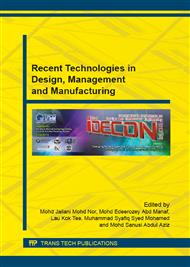p.636
p.641
p.646
p.651
p.659
p.664
p.668
p.673
p.678
Psychophysical Experience and Heart Rate Analysis in Manual Lifting Task of Malaysian Population
Abstract:
Back pain is one of the prevalent injuries that occurs among Malaysian industrial workers. This is due to manual lifting task. Minimal studies have been conducted to determine the effects of manual lifting on psychophysical experience and heart rate of Malaysian population. The objective of this study is to analyze the psychophysical experience and heart rate of Malaysian in manual lifting task. The lifting task was experimented at various lifting heights (55 cm, 75 cm and 140 cm); loads with masses of 5 kg, 10 kg and 13 kg; and twist angles (0°, 45° and 90°). Six male and six female Malaysian students participated as subjects in the experiment. The Likert Scale was used to evaluate the psychophysical experience; meanwhile the heart rate monitor (Polar FT2, Finland) was applied to measure the heart rate. This study discovered that the psychophysical experience recorded the highest rating when performing lifting test at maximum load mass (13 kg), lifting height of 130 cm, and twist angle of 90°. Furthermore, the subjects experienced the highest heart rate after performing lifting test at maximum lifting height (130 cm) and load mass of 13 kg. This study concluded that the load mass, lifting height, and twist angle are proportional to the level of psychophysical experience. Additionally, when the load mass and lifting height were increased, the heart rate was also increased.
Info:
Periodical:
Pages:
659-663
Citation:
Online since:
May 2015
Authors:
Keywords:
Price:
Сopyright:
© 2015 Trans Tech Publications Ltd. All Rights Reserved
Share:
Citation:


